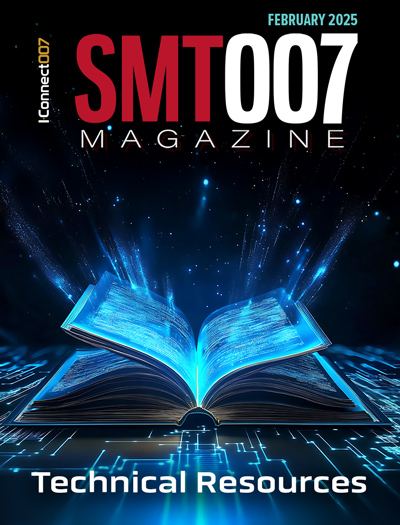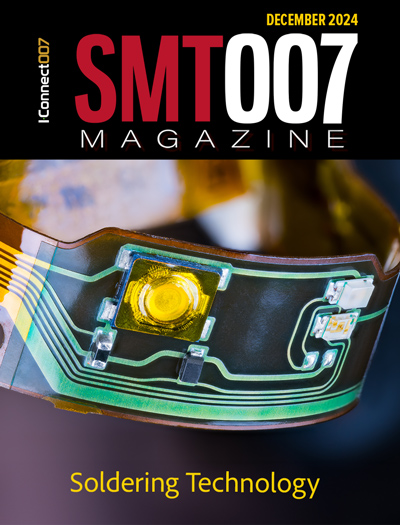-

- News
- Books
Featured Books
- smt007 Magazine
Latest Issues
Current Issue
Technical Resources
Key industry organizations–all with knowledge sharing as a part of their mission–share their technical repositories in this issue of SMT007 Magazine. Where can you find information critical to your work? Odds are, right here.

The Path Ahead
What are you paying the most attention to as we enter 2025? Find out what we learned when we asked that question. Join us as we explore five main themes in the new year.

Soldering Technologies
Soldering is the heartbeat of assembly, and new developments are taking place to match the rest of the innovation in electronics. There are tried-and-true technologies for soldering. But new challenges in packaging, materials, and sustainability may be putting this key step in flux.
- Articles
- Columns
Search Console
- Links
- Media kit
||| MENU - smt007 Magazine
Exploring Innovation Through Alternate Metals and Sputtering
November 11, 2024 | Marcy LaRont, I-Connect007Estimated reading time: 1 minute
Dr. Evelyne Parmentier has a PhD in physical chemistry from ETH Zurich. She was born in Luxembourg and is now a proud resident of Switzerland, where she has been part of Dyconex’s R&D engineering team for the past two years. She loves that her “new” career with Dyconex allows for multidisciplinary exposure to science. “I really enjoy chemistry, physics, materials science, and electrical engineering,” she says. “For me, it is fascinating to see all these sciences together in one industry.”
Evelyne gave a presentation at the EIPC Summer Conference titled “Functionalization of Printed Circuit Boards Through Introducing Alternate Metals Through Sputtered Layers,” where she asked her audience, “If there are 93 metals in the periodic table, why are we not using more of them?”
In this interview, Evelyne discusses this question as she delves into the technical aspects and benefits of sputtering as a metallization process.
Marcy LaRont: Evelyne, you made the comment in your presentation that there are 93 metals on the periodic table, and we should use more of them. Can you elaborate on that comment?
Evelyne Parmentier: Throughout my academic career, I have studied various branches of chemistry, including organic, inorganic, and organometallic chemistry. However, somehow, we never focused on a big part of the periodic table, which is metals. At Dyconex, I was exposed to these very interesting metals, each of which has its own distinct electrical, chemical, physical, and thermal properties. We started thinking, “If we have all these metals with unique properties, then theoretically at least some of them should be able to be used for specific applications.” There should be, perhaps, other metals beyond what we have been using that would also be able to meet the requirements of a particular application. That’s why I started my presentation that way.
LaRont: What was the feedback?
Parmentier: A couple of chemists came up to me and said that they had also never examined other metals in so much detail. In our education, we all learned a little bit about metallic bonding, how metals are built up, and what they have in common, but never how each of these distinct metals behaves.
To read this entire conversation, which appeared in the October 2024 issue of PCB007 Magazine, click here.
Suggested Items
Coherent Evaluates Strategic Alternatives for Its Advanced Lithium-Ion Battery Recycling Technology
12/13/2024 | Globe NewswireCoherent Corp., a global leader in materials, networking, and lasers, today announced that as a result of an ongoing strategic portfolio assessment, the company will evaluate strategic alternatives for its Streamlined Hydrometallurgical Advanced Recycling Process (SHARP™) technology to efficiently recover and recycle critical metals from lithium-ion batteries (LiBs).
Marcy’s Musings: Destination Metallization
10/17/2024 | Marcy LaRont -- Column: Marcy's MusingsTo reach your intended destination, you must have some form of pathway or route upon which to travel. It is much the same with the metallized traces and features on a printed circuit board. They are how electrical signals and power are carried from one point to another in an electronic device. Copper is the most prevalent metal conductor, but other metals are also used to a lesser degree, including gold, silver, tin, and palladium.
Fresh PCB Concepts: The Journey of a PCB—A Tale of Sustainability and Circularity
09/18/2024 | Team NCAB -- Column: Fresh PCB ConceptsImagine a bustling factory floor where hundreds of PCBs hum with potential, each one destined to be the brain of a new electronic device. From the sleek smartphone in your pocket to the intricate systems in electric vehicles, PCBs are the unsung heroes of our digital world. But have you ever wondered what happens to these tiny powerhouses when their work is done? The journey of a PCB doesn’t end when a device reaches the end of its life. In fact, that’s where the next chapter begins—a chapter that’s critical for our environment and our future.
Royal Mint Launches Gold Recovery Factory from E-Waste
08/08/2024 | Royal MintA pioneering new factory that provides a more sustainable source of gold and reduces reliance on mining has been unveiled by The Royal Mint.
Conecsus Metals Mexico to Exhibit Waste Recycling Solutions at SMTA Guadalajara Expo & Tech Forum
07/25/2024 | ConecsusConecsus Metals México, an innovative environmental technology and recycling company, will exhibit at the SMTA Guadalajara Expo & Tech Forum on September 11 & 12, 2024, in Booth #422.


